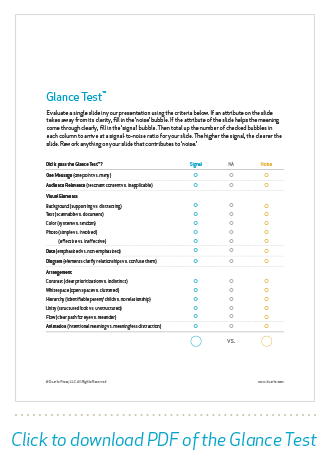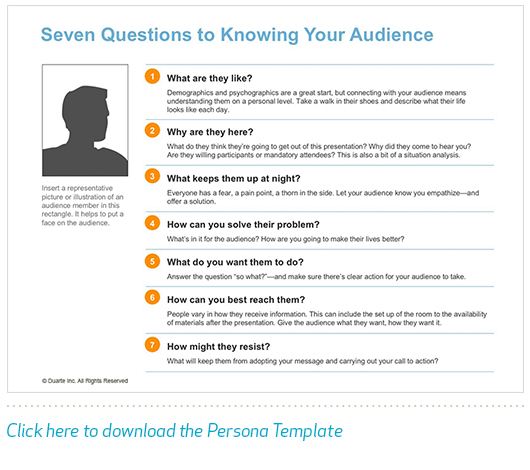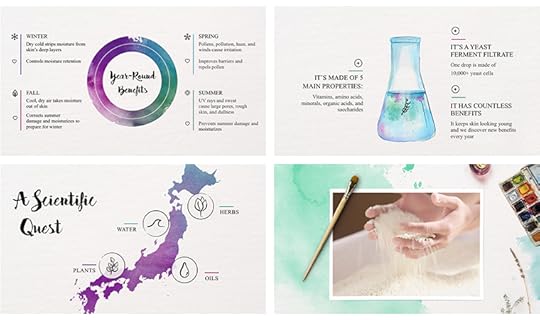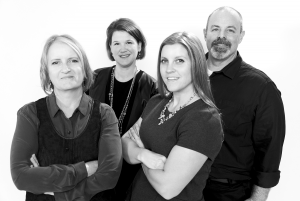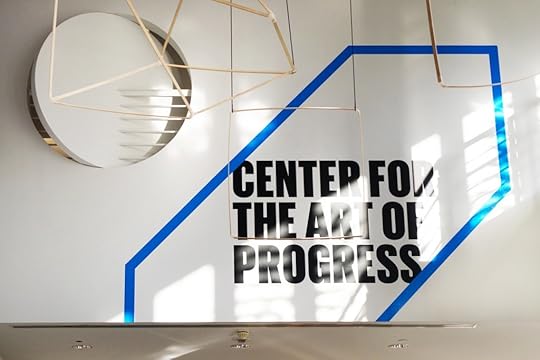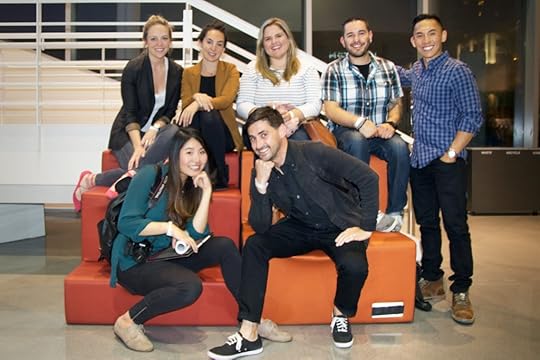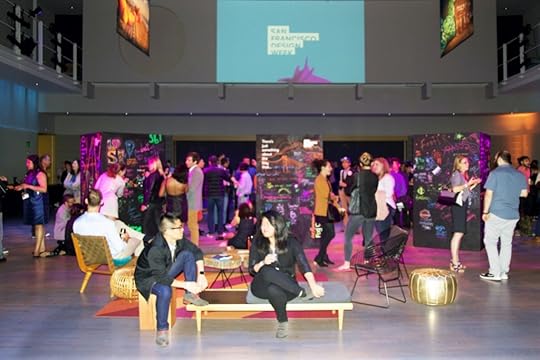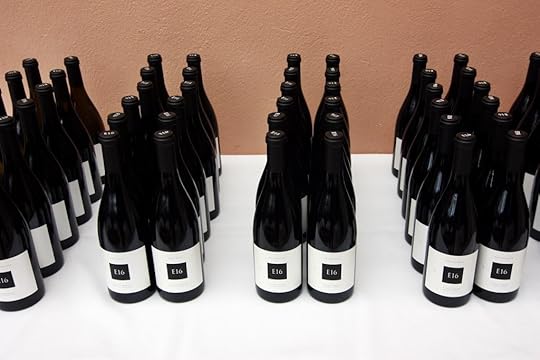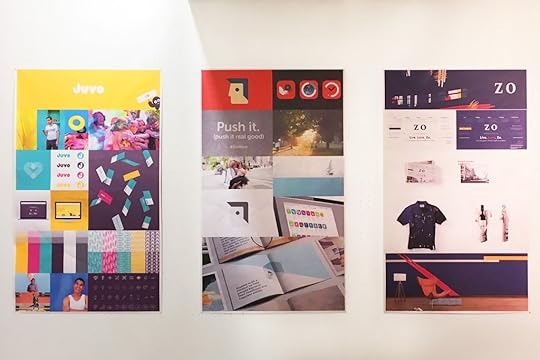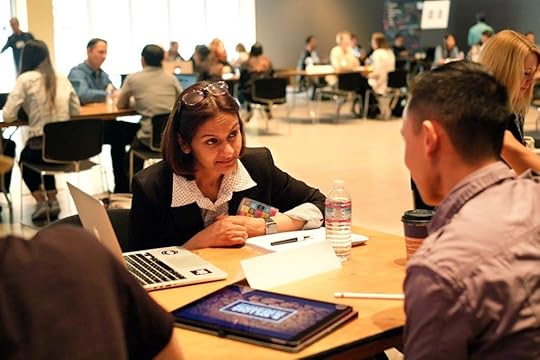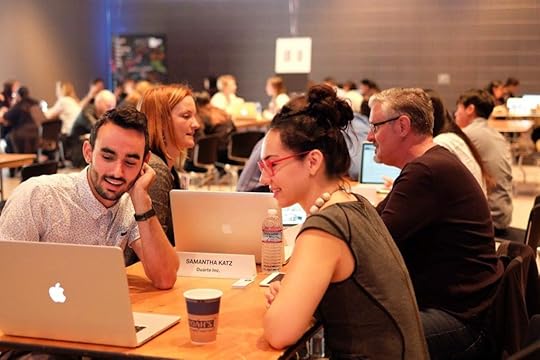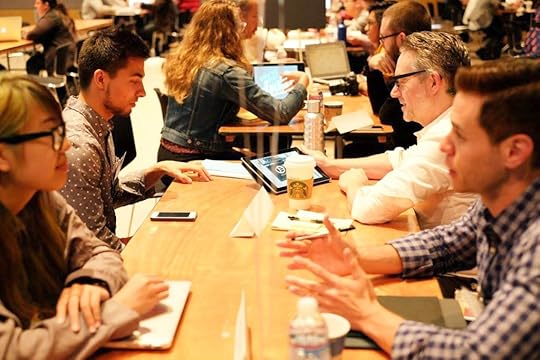Nancy Duarte's Blog, page 22
March 14, 2017
4 Tips and 1 Tool That Will Help You Perfect Your Slide Design
 A good presentation depends, at least partly, on good slide design. Surprisingly, if you want to make great presentation slides, it helps to understand a little bit about the human attention span.
A good presentation depends, at least partly, on good slide design. Surprisingly, if you want to make great presentation slides, it helps to understand a little bit about the human attention span.
Let’s start with you.
Picture yourself arriving at the last presentation you attended. You were probably one of many people there and could melt into the crowd; you were interested, but preoccupied. You had a phone in your pocket, a to-do list in your head, and your next meal on your mind. The presenter was vulnerable. In the next few moments, she could completely captivate you — or lose you entirely.
Despite our penchant to try and do several things at once, studies show that humans can’t actually multitask effectively. Instead, we switch our attention rapidly between tasks. In fact, research shows that “multitasking” gets in the way of productivity, and it decreases our efficiency by as much as 40%. MIT Neuroscientist Earl Miller explains, “People can’t multitask very well, and when people say they can, they’re deluding themselves… The brain is very good at deluding itself.” Couple that with the most popular problem in our technology-obsessed culture, the ever shrinking attention span and it can seem difficult to connect with a crowd and make an impact.
Good news! (I think.) Despite being distractible, we’re also predictable little creatures and there are several reliable ways to capture and keep our attention. When we work with presentations here at Duarte, we start with storytelling, the ultimate attention grabber, which should always direct your presentation structure. However, in this article, we focus on using layout and design to grab your audience’s attention and guide it through the information so your message is broadcast clearly. These lessons apply whether you’re designing PowerPoint slides, Keynote slides, or presenting slides from the back of a napkin, and the best part is that we’ve developed a tool you can use to test if your slides will hit the mark BEFORE you get up in front of a crowd.
Why Good Presentation Slides Must Pass the Glance
Since people can’t multitask, that means that audiences cannot simultaneously read your dense, bullet-riddled slides AND listen to you AND understand what you mean. Thus, your slide should function more like a billboard than any other media.
We call this “glance media.” The audience should be able to quickly grasp the meaning of the slide before turning back to the presenter. And they should be able to do it in three seconds or less.
We also think it’s helpful to think of your presentation slides as broadcasting information the way a radio transmission does—there’s the signal and then there’s noise. Your signal, or message, is susceptible to interference, which can distort the communication and diminish the audience’s ability to discern meaning and intent.
We developed the Glance Test in conjunction with Glenn Hughes at KLA Tencor as a litmus test for the readability of slides; it allows you to quantify the effectiveness of slides as a glance media by calculating a signal-to-noise ratio for each slide. In particular, the Glance Test focuses on the singularity of the message, its audience relevance, the clarity of its visual elements, the data presented, the helpfulness of diagrams, its arrangement, and the animation used.
Before you present, you should evaluate each slide in your presentation using the criteria in the Glance Test. If an attribute on the slide takes away from the slide’s clarity, fill in the “noise” bubble; if the attribute helps the meaning come through clearly, fill in the “signal” bubble. Then total up each column—the higher the signal, the clearer the slide. Rework any items that contribute to the noise.
Essential Tips for Designing Presentation Slides that Pass the Glance Test
If you want to make good slides for your presentation and ensure you design slides which pass the Glance Test, focus on the following aspects while you are creating them.
Design Slides that Communicate a Single Idea
Always keep in mind your ultimate goal: making your information easy to digest and understand. Trying to say too much will confuse your audience and cause you to fail the Glance Test from the start. Restraint is crucial:
On the macro-level, always know your Big Idea. We’re talking about the goal of the presentation. This is also called the controlling idea, the gist, the takeaway, the thesis statement. Every single piece content needs to support this larger mission, so double check that it does.
Limit yourself to one idea per slide. Break-up complicated, multi-part concepts on separate slides and eliminate distractions for the audience, by directing them to focus on key messages and data. Remember, if the information doesn’t directly ladder up to your big idea, kill it.
Design Slides Your Audience Cares About
This might seem obvious, but every presentation should be designed with your audience in mind. However, it gets deeper and more specific than you might anticipate. Every slide, every piece of information you’re presenting should attempt to speak to your audiences’ needs, concerns, and fears. You want to talk to them in a way that builds trust and establishes emotional connections, and you want to anticipate their questions and their resistance. Many people take the audience into account on a macro-level, but if you’re committed to your audience, you’ll keep a persona slide at the beginning of your deck as you’re designing your presentation and refer to it as you’re editing each slide.
Design Simple Slides with a Consistent Visual Style
When you strip multimedia messages of extraneous elements (like excess text, graphics, and animation) audiences learn from those messages more effectively. So, when you’re designing slides, keep simplicity in mind. Rather than adding elements to a slide for aesthetic purposes, ask yourself if there’s a good reason to put the element on the slide. If you can’t think of a reason, then it doesn’t need to be there.
Stick to one consistent visual style when designing your slide deck. Use the same typeface (or two), the same color palette, and photographs in the same style throughout. This helps ensure that audience members don’t have to do extra work during the presentation to process new or unexpected visual elements and that they can focus on the meaning of what you are presenting.
Arrange and Layout your Slides with Care
When you create your slides, pay special attention to how you arrange elements, since arranging them haphazardly can obscure meaning and confuse the audience. Here are several aspects of arranging you should focus on when designing your slides:
Flow: think about how viewers’ eyes will move around a slide. They might notice the biggest and brightest elements first, then move to the other slide elements.
Contrast: Human eyes are drawn to things that stand out. Thus, you can use contrast to focus the audience’s attention. Contrast slide elements using size, shape, color, and proximity.
White space: White space is just what it sounds like – the white, open space around a slide’s items of interest. Include a healthy amount of white space on your slides. This helps sharpen viewers’ focus by isolating the important elements.
Real Life Examples of Slides that Pass (and Fail) the Glance Test
Full disclosure, although we tend to work on developing new presentations here at Duarte, we also work on presentations using building blocks clients already have in place to enhance their everyday presentations.
We use our Glance Test to determine whether slides will be successful or not and to guide the updated design.
The goal of this presentation, which came to Duarte, was to inspire a group of beauty bloggers to feature a new product line on their websites and channels. To achieve this, our client wanted to communicate that there are genetically determined characteristics of skin clarity and that Product X, a scientifically developed organic formula, could improve all those skin conditions in any season.
Their first slides looked like this:
These slides are hard to read! And kind of a bummer. They fail the Glance Test for many reasons including:
There is more than one idea per slide. For example, slide 2 is telling us that there are five factors of clear skin and that there are three key genes—these are two separate ideas and each deserves its own space.
The audience (skincare bloggers) probably doesn’t care very much about “3-key genes” that the scientists who developed the product care about.
The background is noisy and makes the information hard to grasp.
My eye is confused about where to look.
There’s no white space on the slides, the colors are drab, and there’s no clear contrast.
The photographs look random and like they came in from another presentation.
Once Duarte took a stab at it, we came up with this:
We started by telling a story that matters to our audience (the skincare bloggers), and we focused on benefits to the customer.
We chose only the most important ideas for that audience and gave each idea a separate slide.
We chose colors and fonts that support the message, but that also appeal to the audience.
We turned scientific language into understandable language and gave it context that makes it matter.
We used contrast to emphasize what’s important on each slide.
We used white space to give the feeling of luxury and removed the cluttered background image.
We used photos that fit in with the general aesthetic of the slide.
As you can probably tell, this is a completely different presentation — and the concepts and message are clear and precise. These are the kinds of images and messages that will stop a group of technologically-connected, social-media-happy, utterly-distractible, skincare bloggers in their tracks.
This is what each of your presentations should aim to do: appeal to your audience, communicate simply and clearly, and display presentation slides that transform audiences. It takes a lot more effort to be simple and clear than it does to write down everything you know about a topic. Take it from Woodrow Wilson, who said, “If I am to speak for ten minutes, I need a week for preparation; if fifteen minutes, three days; if half an hour, two days; if an hour, I am ready now.”
February 22, 2017
Storytelling and Empathy take Center Stage at the Watermark Conference for Women
A couple of weeks ago, I attended the Watermark Conference for Women in San Jose. About 6,500 attendees, 95% of them women by my estimate, gathered for talks on diversity, inclusion, women’s issues, careers, and trailblazing/innovating/disrupting/leading change.
I left the conference energized and inspired. It also struck me that many of the things that moved me the most were about the two things that attracted me most to my gig at Duarte—the power of storytelling to create connection and meaning among people, and the importance of empathy in communications and relationships.
Here are three of the highlights that reflected those two ideas most; they contain valuable lessons for leaders and communicators who are students of story and empathy.
1. Viola Davis Weaving Storytelling and Empathy into a Life’s Work
Wow. Actress Viola Davis blew the room away in her main stage keynote on the topic of “owning your story.” She described her journey from an 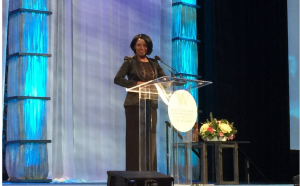 early childhood spent in abject poverty to her famed life today. Whether intentionally or instinctively, Davis used the same tools as history’s most talented orators to keep the audience rapt. She modulated the story between the current state and a better possible future state, and she used plenty of emotional content that the audience could relate to.
early childhood spent in abject poverty to her famed life today. Whether intentionally or instinctively, Davis used the same tools as history’s most talented orators to keep the audience rapt. She modulated the story between the current state and a better possible future state, and she used plenty of emotional content that the audience could relate to.
In Resonate, a book about the art of transformative visual stories, Nancy Duarte introduces the “Sparkline” as a framework for analyzing a presentation. The line moves up and down between “what is” and “what could be,” and changes colors to signify contrast in emotion and delivery. If we analyzed Viola’s talk as a Sparkline, it would be a sterling example of a compelling speech, adhering to the same structure as famous addresses by heroes like Martin Luther King Jr. and Steve Jobs.
Davis’s big idea was that owning your story, even if, or perhaps especially if, your story is hard to own, leads to achievement, confidence, and happiness. Some moments I especially loved were:
I don’t care what other goal you have in life. Nothing, none of it, will do you any good if you do not own your story… Owning it. The good, and the bad.
Davis told the audience about a recent interview with an incredulous reporter who couldn’t understand how Davis was able to realistically portray her character, Rose Maxson, in the movie Fences. Rose’s husband had created a complicated quandary, having cheated on her, impregnated his mistress, and then asked his wife to raise the child. Spoiler alert: Davis’s character Rose says yes. And that’s exactly what the reporter couldn’t grasp.
Davis re-enacted the conversation with the interviewer, saying the reporter told her, “I could never do [what your character did]! I’m so….. put together.” Davis said she tried to explain to the reporter that sometimes people face “Sophie’s Choices,” choices that force a person to dig deep and choose to do something hard. The reporter never came around and instead remained adamant that she’d never do such a thing. And that’s when Davis hit us with the moral of the story: “If that reporter had owned her story,” explained Davis, “if she had said something more like ‘I don’t think I could ever do that, but you know? There are some things I have done, some things that I’m maybe not so proud of,’ well, in that ten minutes of that interview, we would have made a connection. Even if just for those ten minutes, we would have had a connection.”
The power in one’s story is it connects us to people, and it relinquishes fear. Shame cannot exist when you share your story with people who have empathy.
Davis compared the classic “hero’s journey” to her own struggle trying to escape from a childhood where she was chased with bricks after school by boys who taunted her with racial slurs. She said she ran from them, ran home to a rat-infested apartment where her father’s violence was a constant threat. “Poverty is not just a financial state. It gets in your mind. It destroys psyches. It destroys families.”
Like the classic hero, as early as age 9, Davis knew she had potential, but, like the hero, she needed a mentor to help draw it out of her. For Davis, the motivation came in the form of a one-two punch; the first from an older sister who prodded, asking what Davis what she would do with her life. The second was the idea she got when she watched Cicily Tyson in The Autobiography of Miss Jane Pitman on TV. It was then Davis decided she’d be an actress, “At some point, the hero finds that sweet elixir, the answer, the answer to the point of their lives. And then they slay dragons. My mamma gave me a crochet needle, and I started to face down those boys with it. Slaying the dragons, with a crochet needle.”
2. Albright and Rice Finding Human Connection Across the Aisle With a Shared Story
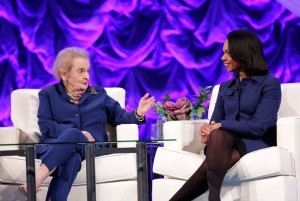
Madeleine Albright and Condoleezza Rice, the first female U.S. Secretary of State and the first African-American female Secretary of State respectively, pulled no punches discussing U.S. political affairs in a conversation with Kara Swisher. Albright was on fire with crushing one-liners about how frustrated she is by the Trump administration (it’s fun to hear the well-coifed, 80-year-old, ever-composed, Albright drop the f-bomb). Rice was characteristically more tempered – she urged people to panic less and trust in checks and balances and the system to constrain the power of the president.
But while politics and the opinions of these two luminaries were on everyone’s mind, what moved the room most was when Albright and Rice stepped back to tell a shared story of a moment in their shared past. Albright began by explaining that her father (a refugee from Czechoslovakia) was a professor in Denver in the 1970s, and one of his star students was Condi Rice. In fact, Rice added, it was Albright’s father who’d encouraged her to pursue her Ph.D. and go into diplomacy and politics after she decided to drop her music major, and they remained mentor and mentee after that. Albright took back the mic and said that later, on the Dukakis campaign, she tried to recruit Condi to help provide foreign policy advice. Rice butted in. “I said, there’s just one problem, Madeleine. I’m a Republican!” Albright put her hand on Rice’s and said, “and I said, ‘how could you be?!?! We had the same father!’” We all felt like friends in the room at that point. It was a touching moment. And then Albright got straight back to politics with a quick shot: “Just realize, a refugee immigrant trained two U.S. Secretaries of State.”
3. Elizabeth Gore on the Empathy and Technology Partnership
The breakout panel sessions had titles like “Forging New Pathways…. Insights for making the seemingly possible a reality” and “Trailblazers, Pushing the Envelope and Leading Change.” In the two sessions I attended, each (fabulous, accomplished) speaker on the panel shared something about how they got where they were, and then fielded questions on what made them successful.
I asked Elizabeth Gore’s panel about how empathy and communication have contributed to their success in moving people. All the panelists had an answer, but Gore’s was particularly insightful. She said,“Technology does not take away empathy. Dell acquired a company this year called Pivotal…. They have 3,000 employees, and most of them are engineers and coders, probably the most deeply technical folks, who a lot of people would have blanketed as, they can’t communicate, they’re just too smart. The CEO of Pivotal actually does an “empathy test” for every hire at Pivotal. He says, it’s because the code is ultimately about the end user, who is a human. And so, he believes they have surpassed other companies like them because of this empathy test, because these folks can communicate.”
Stories are everywhere, no matter who you are or where you’ve been. And they’re powerful at forging connections and moving hearts and minds. It was more than just a professional delight to see stories being used so powerfully at the Watermark Conference this year. The stories connected me to my fellow attendees in meaningful ways. They moved me. Which, when you think about it, is exactly what events like this are all about.
January 20, 2017
Be Dramatic, Be Memorable
“There is no quality in the world that is not what it is merely by contrast.”
- Herman Melville, Moby-Dick
When you think of the word “dramatic” you probably think of things like:
The steep, chasmic gulf of the Grand Canyon.
The sudden, violent shower scene, thirty minutes into Alfred Hitchcock’s “Psycho”.
The chiaroscuro lighting effect in Rembrandt’s painting, “The Night Watch.”
Each example is dramatic—sudden, striking, exciting or impressive—in its own unique way. And yet, each includes the key element that makes something dramatic:
Contrast.
Too many presentations are forgettable because they aren’t dramatic.
And they’re not dramatic because they don’t have enough contrast.
Contrast occurs when one thing (image, sound, emotion) is juxtaposed with something else strikingly different.
The Grand Canyon is dramatic because it’s a massive hole contrasted by the surrounding, flat Arizona desert.
Marion Crane’s murder in “Psycho” is so startling because it stands in stark contrast with the non-violent, dialogue-heavy act before it.
The deep black shadows contrasted with the bright shafts of light in “The Night Watch” bring drama to what would be an otherwise ordinary painting.
So how can you add contrast to your next presentation?
Visually
Too often, slideshow presentations lack any contrast at all. Slides are so busy and full of information that nothing truly stands out, or each slide looks like a slight variation of the one before it.
To produce contrast, go through your slide deck and pare back your text so only the key message comes across. Try using thick lettering against a simple, solid-colored background. (It may sound plain, but the contrast will help your words jump out at your audience.)
Be sure you have a variety of slides, too. Try to follow a data slide featuring a chart or graph, with a full-screen image with a simple word or short phrase on it.
The human eye is drawn to contrasting images. Use this insight to create a slide deck that truly pops.
Verbally
The opposite of dramatic is monotonous. And there are few things worse than listening to someone drone on in the same tone.
As you present, speak in a higher pitch when you’re really excited about a point and speak lower when you’re trying to convey something serious. Alternate back and forth as much as possible to contrast one tone with the other.
Don’t be afraid to alter the volume of your voice, too. Be loud at times, and soft and quiet at others. This will keep your audience alert and listening. Just remember the old acting adage: “If you’re always shouting, you’re never shouting.” Don’t just be loud. Be loud and quiet.
Physically
If at all possible, don’t stand in one place. Create contrast with your body position on the stage (or the area you’ve been given to present from). Move along the X-axis, back and forth in front of your audience.
Don’t limit yourself to the X-axis, though; use the Y-axis, too. Move toward the audience and away from them. Benjamin Zander loves to actually go down into the audience during his presentations to actively interact with his listeners.
Before you give your next presentation, use the guidelines above to determine if your presentation feels “contrasty” enough. But consider other ways to add contrast, too. Maybe it’s by varying the media you use (placing a colorful, animated clip in the middle of a series of static slides), alternating between case studies and straight-forward facts, or bringing up other speakers to present certain points of your presentation.
When you give a presentation that’s full of contrast, creating dramatic moments, you help keep your audience interested, engaged, and more likely to respond to your message.
December 29, 2016
Duarte.com/edy Vignette #1: Get to the Point
When presenting to executives, there are things that work and things that fall flat. Get to your point quickly, and you’ll avoid the trap that most presenters fall into.
See more hilarious presentation lessons at duarte.com/edy or our YouTube channel. Or, send Bob and Finn a quick note on Twitter (@BobandFinn) to let them know what you think. (They might just write you back!)
November 16, 2016
Duarte Launches New Strategy Practice to Help Leaders Spark and Sustain Movements
For the past 30 years, Duarte has played a role in many movements that matter, including its work with Silicon Valley’s leading brands such as Cisco and Salesforce, former Vice President Al Gore’s “An Inconvenient Truth,” and the transportation revolution led by Hyperloop One.
Today, we’re thrilled to announced the launch of a new strategy practice at Duarte that’s focused on building support for bold ideas and sustaining change over time. Our new consulting offering will help address an expanding need for our clients to help them deliver high-impact communications that effectively move large numbers of people to belief and action. During recent years, we’ve seen a rising importance of movements in the world around us. The new practice we’re launching today is in response to that trend.
Inspired by the 2016 book Illuminate that I co-authored with Nancy Duarte, our new practice’s methodologies are built on a proven framework to lead people through five stages of transformation and practical communication tools to inspire others to support and execute a big vision or idea. Through years of in-depth research into the communication practices of great leaders like Apple’s Steve Jobs, Starbucks’ Howard Schultz and Dr. Martin Luther King Jr. we uncovered a pattern in how they motivate and mobilize the masses, and now are applying that pattern to help others do the same.
Great leaders create a feeling of hope that inspires people to contribute extra energy to a transformation until they arrive at the goal. The vision – or dream – of the end state must be so compelling that it creates a sense of longing to pull employees, partners, and customers toward the future. To sustain people’s interest and commitment over the long haul, leaders need to deliver an ongoing stream of meaningful and timely communications that are articulated with clarity, passion and empathy.
Our new team of senior strategists are veterans of moving audiences through systematic use of empathy, storytelling and impactful moments. They are Becky Waller Bausman, SVP of Strategy at Duarte, whose background is rooted in positioning and product strategy; Dave DeFranco, who’s led sales enablement and change initiatives for many of the world’s largest B2B tech companies; and Brie Osgood, who has deep experience with executive communications at Moody’s, Johnson & Johnson, HP and Hewlett Packard Enterprise.
To meet our team and learn more about how Duarte can help business leaders move people to embrace bold visions and carry them forward, please visit: www.duarte.com/strategy.
Illuminate: Ignite Change Through Speeches, Stories, Ceremonies and Symbols is available for purchase on Amazon, Barnes & Noble, iTunes and 800CEORead.
October 31, 2016
Trick or Treat: Costumes, Pumpkin Carving, Harry Potter Hogwarts School Halloween House Will Treat Visitors to Augmented Reality “Wizardry”
At Duarte, Halloween is one of our favorite holidays and lets us flex our creative thinking and design skills every year – and this year is no exception. After months of planning, today we get to share our magical creations with our fellow co-workers as well as the broader San Jose, CA community. Kicking things off today will be our annual costume contest and the final votes will be tallied to determine the winners of our pumpkin-carving contest.
Duarte designers show off their talent in the annual pumpkin contest. Get inspiration for your own pumpkin carving, and vote for your favorite pumpkin here http://www.duarte.com/halloween/

Duarte Halloween Pumpkin Carving Contest
Harry Potter: Hogwarts School of Witchcraft and Wizardry Halloween House
The Albertson Halloween House is created by the community (neighbors, co-workers, school friends and more) in the Northside neighborhood in San Jose, CA having been a regular Halloween favorite for 15 years. The house is built using recycled or donated materials and welcomes 800-1,200 trick-or-treaters each year and is also a glow necklace distribution house to help kids remain safe on Halloween.
The Albertson Halloween House (free community event with no entry fee)
497 North 16 St., San Jose, Calif. 95112
Monday, October 31 from 6pm to 9pm
Website: http://www.albertzone.com/halloween/

Harry Potter: Hogwarts School of Witchcraft and Wizardry Halloween House, San Jose, CA, October 31, 2016 from 6pm-9pm
The theme for the 2016 Albertson Halloween House is Hogwarts School of Witchcraft and Wizardry where visitors will get to feel what it is like to be on the grounds of Hogwarts. After weeks of work, many people painting, cutting, building and helping, the time came to set everything up. On Friday, we set-up the backdrop structure and Saturday was the big moving day. We needed to find a way to move a 12 ft. X 22 ft. cathedral-like entrance to Hogwarts from our backyard and in to place in the front yard.
Here’s a link to some photos (photo credit: Bethany Lewis).
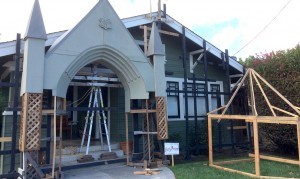
Building Hogwarts School of Witchcraft and Wizardry
Visitors will “experience” Hogwarts School
Visitors to this giant Harry Potter themed Halloween house will walk past Hagrid’s hut and Platform 9 3/4 into the grounds of a 22 ft high Hogwarts School of Witchcraft and Wizardry. Over 20 cosplayers, embodying Hogwarts teachers, students and other characters from the Wizarding world, will greet visitors and help to make this an unforgettable, immersive experience. In addition, the house will feature a photo op (at Platform 9 3/4) where visitors can snap a photo as they push a trunk-laden cart ‘through’ the barrier and alongside portraits that move, a giant spider, Hagrid’s hut, and more.
Cosplayers to be on site:
Hogwarts Students – Harry Potter, Hermione, Ron Weasley, Luna Lovegood, Cho Chang, Hufflepuff Quidditch Player, and more
Hogwarts Professors – Professor Dumbledore, Professor Snape, Hagrid, Professor Umbridge, Professor McGonagall, Professor Slughorn, Mad Eye Moody, Others
Others – Mrs. Weasley, baby Harry Potter, Quidditch fans
Special Guests:
The South Bay Blazers (San Jose’s local Quidditch team) said they would make an appearance! https://www.facebook.com/SouthBayBlazers/
Keep an eye out for magical items (can you spot them all?):
Horcruxes –Tom Marvolo’s ring, Ravenclaw’s diadem, Hufflepuff’s cup, Slytherin’s locket, Tom Riddle’s diary
Treasures – The Tri-Wizard Cup, the Sword of Gryffindor, the Sorting Hat
Other Items – Moving portraits, floating candles, potions from Snape and Professor Slughorn’s stock, Dumbledore’s penseive (complete with case for storing vialed memories)
Augmented Reality: HP Aurasma and Harry Potter Spells Apps
In addition to the immersive scene, the house will feature several augmented reality experiences. Using the HP Aurasma app (a free app that enables augmented reality on iPhone, Android, etc.) items viewed through the app will come to life.
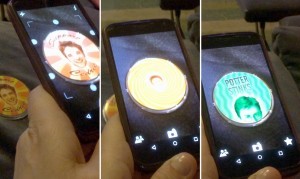
HP Aurasma App-enabled Magic on Halloween
Items which will come to life with Aurasma:
‘Have You Seen This Wizard?’ poster – The photo of Sirius Black moves, showing him fighting against his restraints before being taking to Azkaban
‘He Who Must Not Be Named Returns’ poster (on brick wall) – Bricks move away to reveal a hole through which you can see Diagon Alley (and a dragon that passes by and breathes fire)
‘Myrtle Missing’ poster – ghost of Moaning Myrtle appears to welcome you to Hogwarts
‘Support Cedric’ buttons (worn by cosplayers) – animates, changing its message first to ‘True Champion’ and then to ‘Potter Stinks’
For more information and instructions for how to access those experiences through your phone, see this blog post: http://www.albertzone.com/halloween/2016/10/app-enabled-magic-on-halloween/
You Tube Video with instructions: https://www.youtube.com/watch?v=A8Vc8hUDqHg
Visitors are also encouraged to utilize the Harry Potter Spells app, which turns a phone into a wand. This free app allows you to learn the wrist movement for Harry Potter spells and even duel with a friend.
Everyone is invited to come to the Hogwarts School of Witchcraft and Wizardry tonight. We hope to see you there!
October 27, 2016
How to Illuminate the Future and Inspire Others to Follow
To thrive in the long-term, organizations must continually reinvent themselves to avoid decay and decline. To envision the future is one thing; getting others to go there with you is another. By harnessing the power of persuasive communication, you, too, can turn your idea into a movement.
Steve Jobs wasn’t just a founder and driver of Apple; he catalyzed a movement. Whenever Jobs took to the stage to talk about new Apple products, the whole world seemed to stop and listen. That’s because he was offering a vision of the future. He wanted each person to realize what the world could become and trust him to lead the way to this new world.
Great leaders create a feeling of hope that inspires people to contribute extra energy to the transformation until they arrive at the goal. To move travelers to jump in and stay the course throughout a potentially long and arduous journey, leaders must communicate in a way that overcomes resistance and reinforces commitment.
On October 27, 2016, my colleague Patti Sanchez and I participate in a live, interactive Harvard Business Review webinar to describe the tools of master communicators. We’ll be sharing specific examples and best practices from our book Illuminate: Ignite Change through Speeches, Stories, Ceremonies, and Symbols.
Last week, Patti and I had a lively Q&A session and you’ll find some of the best excerpts from that event below. We hope you’ll be able to join us for our 10/27/16 HBR webinar for a similar session and Q&A conversation. Here is where you can sign up for free.
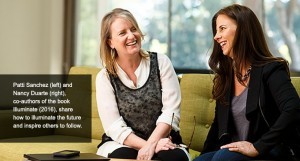
Patti Sanchez (left) and Nancy Duarte (right), co-authors of the book Illuminate (2016), share how to Illuminate the future and inspire others to follow.
Here are some tips to help business leaders illuminate the way, move people to embrace their bold visions, and carry them forward. You can #IgniteAMovement:
Q: Is it important for leaders to use personal stories to convey their vision?
Me: There’s a need for corporate stories to be told, and every organization needs to have a folklorist. But, you also need to have your own collection of stories that are more personal ones because a personal story told from a place of conviction is the most persuasive device there is. More so than anything else, a really transformative story told with personal conviction and passion from a leader actually transforms more greatly than anything.
Patti: I think a relevant example from one of the CEOs Nancy and I both have a crush on: Howard Schultz of Starbucks. He regularly tells the stories of his life. For instance, growing up and seeing his father suffer an injury and not get healthcare covered by his employer. That became a galvanizing experience for Schultz and shaped his value system. What Starbucks chooses to invest in now for its employees is directly from his personal experience growing up. He communicates that all the time to help people understand its values.
Q: Are there exercises to improve storytelling skills, like learning to play piano?
Me: We’re developing a story workshop now because there’s real magic in telling a good story. Our new story-making tool has been tested internally, and we think it’s going to work great. If it works on me, it’s going to work on the world, but we have a method. The power is actually in using a story at the right time and the right place because some people will feel like you’re telling a story to manipulate. That’s the last thing you want. You want it to feel like it’s fueling the communication at the time.
Patti: In our book, Illuminate, there are many examples of stories you can tell in different stages of a journey. It’s important to remember that the audience you’re talking to should be the hero, not you. Don’t choose something that’s going to glorify you. Instead, it’s much better to choose something that will help them.
Q: What are some examples of ceremonies?
Patti: We have our own at Duarte. One is this little ritual of recognition with a giraffe. It’s been our symbol for many years after an employee gave one to somebody who was working really hard. It’s now a ritual to stand up at our staff meeting, call someone to the front of room, hand them a little giraffe statue and recognize them for their effort. It’s our own small kind of award ceremony.
Pledging commitments are another good example. People can pledge commitment to a project just by signing a document like how Apple’s Mac team signed the inside of the first Macintosh. There are also mourning ceremonies. One example is about Steve Jobs holding a mock funeral for the Mac OS 9 product when he wanted to convince developers it was really dead and time to move on to next platform. During a big launch event, Jobs had a large coffin on the stage behind him with an over-sized box of the Mac OS 9 in it. He gave a eulogy for the old product. While it was theatrical, it was a really a powerful way to communicate that an ending had come. Ceremonies are about beginnings and endings.
Q: How do you translate financial metrics of interest to C-Suite into a storyline?
Me: For financial information, you can create a story arc at the beginning with the data’s meaning and narrative, and then support it with some sort of an appendix. Typically, you’re given only 30 minutes with a senior executive, and it’s a struggle to get everything out because they’re going to interrupt you. You need to build a case that’s interrupt-driven. Moving back and forth rapidly between what is and what could be is very important. In reality, we suggest that you flip the form. It’s the only instance where you flip the form. You state the new bliss, they see most of everything and you tell them: “This is what I need to make it reality,” then you move back and forth between what is and what could be so rapidly with data to back it up – in between the interruptions.
Patti: Another tip: once you drop everybody’s shoulders down by answering the financial and data-driven questions of most interest, you’ll often earn the right to go a little bit longer and tell your actual story. We helped one global retailer’s HR organization make the case to the board about significant, big investments they were asking for, which was a difficult ask because HR is not a profit center. We helped them tell a story about how these investments would change the daily lives of employees by using an actual employee as an example. It was hugely powerful and effective because they could see tangible evidence of what this strategy and required money was going to buy them.
Q: Do you share good examples of how to onboard new team members in your book, Illuminate?
Me: A bunch of content we wrote for Illuminate hit the cutting-room floor. There was a great example I loved from Aileen Lee, a famous venture capitalist at Cowboy Ventures. When one of her startups gets funding, she sends them a disco ball. That’s part of the ceremony. It’s like saying: “Dance your butts off, because you’re going to be working hard.” At Duarte, our new employees get a standing ovation when they leave the office on their first day. It’s not a ceremony that management came up with, it grew organically from our people. It wasn’t like I stood up and started clapping. Instead, it was just this natural gift of affection for new people. That’s the thing about ceremonies.
Patti: I think that’s a really important point. The most powerful ceremonies that have the most meaning for people are most typically created organically from a company’s staff. If you’re trying to imagine what your symbol or ceremony might be, it’s a great idea to study how your people behave with each other already. Find those nuggets that are already in your culture. Pluck out the thing employees are energized by and amplify it.
###
Patti and I hope that you’ll be able to join us for our next Illuminate webinar and Q&A session hosted for free by the Harvard Business Review on October 27 at noon EDT/9am PDT.
For more information on Illuminate and where to buy it, visit: www.duarte.com/Illuminate
June 30, 2016
East Meets West: From Big Apple to Bay Area
After living in New York for most of my life, I knew that moving to the Bay Area would offer an exciting new environment. After making the move, I realize that the changes go far beyond the physical.
Before the move, I worked in a private office filled with monochrome furnishings, overlooking a sea of sleek black high-rises from the 29th floor of the Sony building in the heart of New York City. Today, I work in a single-story building with an open floor plan, colorful furniture, and floor-to-ceiling windows in the heart of the Bay Area. Instead of black high-rises in a concrete jungle, my neighbors are some of world’s largest tech companies, who are innovating the latest in technology every single day. Neither one is better than the other, they’re just different.
Having been pretty involved with the design community back in the Big Apple, I was eager to explore the creative landscape here in the Golden City. And attending San Francisco Design Week was the perfect opportunity to dive-in. A group of Duartians (yes, that’s what we call ourselves) attended the event to meet other creatives in the community and exchange ideas on the ever-changing landscape for design. For me, this was not only a party or an opportunity to press palms, but an exciting social exercise whereby I could really begin to identify the distinctions between these two major metropolises.
First, it is worth noting that kick-starting a career in New York is no easy feat — gaining access to other experienced designers and reliable mentors requires lots of socializing, self promotion, and membership fees. San Francisco’s design culture is quite the opposite, seemingly offering more opportunities for inclusion. In general, creative designers in the Bay Area are more approachable. Perhaps it is the shared mentality that, “If at first you don’t succeed, try again” whereas, in other cultures, failure prevents most from even trying.
This concept especially applies to ones’ networking approach. While New York is often coveted for its exclusive nature, at SF Design Week it was not uncommon to encounter founders, investors and creatives talking shop and sharing ideas. The energy and aggressiveness of New York does make it a hub for exceptional creative talent, but folks there often move fast, just as the city itself does. Even frequenting the design circuit, it was not uncommon to meet somebody at an event and never see that person again.
My first Design Week in SF was anything but rushed or restrictive. At the Yerba Buena Art Center on opening night our whole team mingled with other designers, brand specialists, business owners, and new friends. We even interviewed a handful of exciting young professionals, inquiring about what they enjoy most in relation to the SF design scene. We got answers like, “It’s extremely diverse in SF. People from all around the world come to this one little town. Here there is the the opportunity to work amongst the best. Greatness inspires greatness” and, “I like that here you get a glimpse of what’s next in the world, because we always have our finger on the pulse.” (View more from this series of contribute your own conversations using the hashtag #AllDayAIGA).
On the following day, a Senior Designer from Butchershop invited me to their agency’s event Booze Your Words: After-Work Wine Pairing. The premise was that Butchershop’s designers teamed up with producer, E16 Wines, to put a unique twist on pairings, coupling reds and whites with a curated selection of complimentary type-faces. Yet another example of an inclusive activity with substantial purpose, connecting and encouraging all who attended to mingle, view the portfolio of work featured throughout the studio, and engage in open dialogue about the enticing theme of the evening.
Then on Saturday I participated as a Reviewer at the AIGA San Francisco Portfolio Day along with two other Art Directors from Duarte, where we chatted with recent graduates and aspiring industry professionals. Having become familiar with both sides of the Portfolio Day desk, as a student and then as an Art Director in New York, I vividly recall how intimidating the experience was. Akin to modern-day-dating, the mission was to find the most accomplished person in the room, and present your best elevator pitch with the hope that, by the time it was over, they’d be ready to join your company / offer you a job. Contrary to this objective-oriented approach, the Portfolio Day at YBCA was casual and convenient. I learned a lot from those fresh faces who sat eagerly in front of me, sporting big smiles and impressive technological devises. And they seemed to learn a lot from me, too!
Diving deep into each portfolio, the intent was less about whether or not business cards would be exchanged at the end of the conversation, and more about how I could lend a unique perspective in my career at Duarte as a visual storyteller. As the rotation of attendees continued, one girl even sprinted to my station, asserting “I heard you’re awesome – let’s talk!”
The remainder of the week was filled with further phenomenal programming and highly enthusiastic happenings. Each of these experiences led to the revelation that here in San Francisco the design community mirrors the same cultural environment that we do at Duarte: “It’s a place to express yourself, find your passion, fuel your creativity, and make lasting friendships.”
June 20, 2016
The Secret Sauce of Successful Commencement Speakers
It’s that season again. Every time you open a page of news headlines, a social media feed, or a message from a family member or colleague, you stumble across yet another inspirational commencement speech. If you’re like me, you’ve seen enough of them that they’ve all started to blend together. Besides, who has the time to watch a 20-minute YouTube video? That’s practically enough time for a full-length sitcom episode, and I still haven’t caught up on Unbreakable Kimmy Schmidt.
But against all odds, and among a sea of choices, every year a few rise to the top, speakers so good, so unique, and so profound that you can’t help but find yourself listening to the whole thing. This year, more than a few political leaders, entertainers, and thought leaders made the rounds on the commencement circuit. A few were good; a few were not; and a few left an impression that will stay with me for a while.
What stood out?
For one, they were funny. Whether setting the tone for an entire speech or sprinkled in at key moments, humor plays a huge role in most successful commencement speeches. Matt Damon set this year’s standard for self-deprecating jokes in his commencement address at MIT, making fun of his second “fake graduation” from college and reading aloud a terrible review of Good Will Hunting.
Let’s just put that out there. I mean, I’ve seen the list of previous commencement speakers: Nobel Prize winners. The UN Secretary General. President of the World Bank. President of the United States. And who did you get? The guy who did the voice for a cartoon horse.
Damon wasn’t the only one who dared to make fun of himself. Even the President of the United States, Barack Obama, made fun of himself in his address at Howard University, saying, “I used to joke about being old. Now, I realize I’m old. It’s not a joke anymore.”
Both President Obama and Damon used humor strategically to build a rapport with their audience. Others used another tool: sharing their own stories of struggle and growth. Sheryl Sandberg made headlines when she publicly addressed her husband’s death for the first time in her commencement address at the University of California at Berkeley. In sharing her own experiences, she told the graduates what she had learned over the last year: “The easy days ahead of you will be easy. It is the hard days—the times that challenge you to your very core—that will determine who you are. You will be defined not just by what you achieve, but by how you survive.” Life advice like this comes standard in commencement speeches. What made Sandberg stand out was her willingness to open up about her own life—some of her deepest, darkest, saddest moments—to help the audience understand exactly what she was saying.
Other speakers went beyond general life advice. In a year focused heavily on politics, presidential elections, and social change, many speakers used their commencement speeches to call on graduates to change the world. Unsurprisingly, President Obama made the case for change in his addresses at Howard University and Rutgers University, encouraging the graduates at Howard to move beyond “righteous anger” towards organization and activism.
You have to go through life with more than just passion for change; you need a strategy. I’ll repeat that. I want you to have passion, but you have to have a strategy. Not just awareness, but action. Not just hashtags, but votes.
Similarly, First Lady Michelle Obama reminded the graduates of the City College of New York that “our greatness has always come from people who expect nothing and take nothing for granted—folks who work hard for what they have then reach back and help others after them.” But the calls for action didn’t just come from the Obamas. Director Spike Lee encouraged the graduates of Johns Hopkins to “wake up” to the injustices and inequalities of the world they live in. And between his jokes, Matt Damon encouraged the graduates of MIT to choose among the “world’s worst buffet” of problems and “go out and do really interesting things. Important things. Inventive things. Because this world … real or imagined … this world has some problems we need you to drop everything and solve.”
Using humor effectively, sharing personal stories, and calling for action all play important roles in successful graduation speeches. Like a great chef, each speaker uses those ingredients in different combinations to create something uniquely personal. But some add a little extra spice that makes their concoction stand out from the crowd. This year, two addresses did just that. Lin-Manuel Miranda gave a powerful speech at the University of Pennsylvania in which he reminded graduates that “the stories you are about to live are the ones you will be telling your children and grandchildren and therapists.” (But for anyone who saw it, the standout moment came when the university Provost freestyled his way through his introduction of Miranda.)
And in a season full of celebrity speakers, perhaps the most unique, powerful, and memorable of all speeches—and this writer’s all-time favorite—came courtesy of someone whose name you’ve never heard. Donovan Livingston, Ed.M. candidate at the Harvard Graduate School of Education, used his moment at the podium to share his gift of spoken word poetry with the world.
At the core, none of us were meant to be common. We were born to be comets, Darting across space and time —Leaving our mark as we crash into everything.
I didn’t even know I liked spoken-word poetry. But as I listened to Livingston speak, I felt the goosebumps rise and the tears come to the corners of my eyes. This is what speeches are for. This is what words can do. When put in the right hands, language can be a powerful tool to remind people of the best and the worst of what’s possible. Livingston gave that gift to the Harvard graduates that day, and—thanks to the Internet—to all of those lucky enough to hear him speak. He set a new standard for commencement addresses. I look forward to seeing which members of next year’s class rise to the challenge.
June 7, 2016
My First Year – From Intern to Duartian
Presentation design? What does that even mean?
These were my initial thoughts as I walked into the shop that would soon become my first job out of college and the start of my professional design career. During finals week of my last quarter, I drove from UC Davis to Sunnyvale with some friends so we could visit Duarte’s beautiful office for their Studio Tour as part of SF Design Week 2015.
Little did I know that exactly one year later, I would see it come full circle and be sitting amongst the designers in the shop as one of their very own!

Here’s a snapchat I took with my friends Lillian and Chris before walking into Duarte’s studio tour last year.
Like every bright-eyed college graduate, I was looking for the next big thing. I attended AIGA’s annual Portfolio Day where I met the wonderful Dave Nguyen. My forever MRMF (mentor, role model, and friend – yes I came up with this just now), who eventually led me here to Duarte where I have gained so much more.
As part of last year’s Studio Tour for SFDW, my friends and I were greeted by several Duartians (yep, that’s what we call ourselves) at the door who guided us through the shop like museum curators at the MOMA. This walking gallery tour gave insight into the creative process of how the various teams (i.e. Academy, Account, Content, Design, Events, Multimedia) work together to create a visual narrative for any speaking engagement.
Whether it’s a large scale presentation that’s shown inside a convention center for thousands to see to an intimate 1:1 conversation where the presenter is using an interactive kiosk to “touch” their way through a story. These mediums require a variety of skillsets to come together and the designers who work here come from all types of backgrounds. Whether it’s branding, identity, motion, user experience, print, packaging or fine art, each of these designers found a home here where their unique skillsets come into play.
Our job as creators is to further define any medium and also define a new cliche and not to adhere to generations past.” —Casey Neistat

Jack welcoming us, as we walk in through the front doors.
It’s been amazing to learn and see how much work goes into a presentation, whether it be the content or the design. Knowing that the work we create here has the ability to ignite change is incredibly humbling. Storytelling has been the main form of communication since the beginning of time and it has such a powerful effect on people.
I love that I get to be a part of this everyday.
Since that tour, I immediately applied for the summer internship program and have happily joined the ranks in the Design group. I’ve had the privilege to collaborate with some amazingly talented creatives, see my designs blown up on giant screens in both large indoor and outdoor venues and use our methodical process here at Duarte to solve challenges with clients from some of the top Fortune 500 companies around the world.

Logan and I (as strangers) standing right across from each other before we knew we were going to end up at Duarte together.
Looking back now, I’m glad that I attended Portfolio Day/SFDW last year and very lucky to have the opportunity to work with such thoughtful and talented people. The saying is true – you never know who the person you’re sitting next to might be. I’m looking forward to this year’s design week, and meeting new people/making new friends. If you’re interested in learning more, you can find me on the internet (@annieeplum).
If I ask you to think about something, you can decide not to. But if I make you feel something? Now I have your attention. –Lisa Cron


